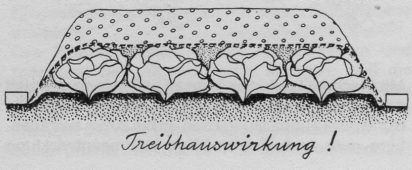 Temporary covering with perforated foil has proved to be quite effective.
Temporary covering with perforated foil has proved to be quite effective.
A thickness of polyethylene film is used for this purpose 0,05 to 0,15 mm. Punching the foil takes less time , than it first appears. The film is folded several times and placed on a firm surface, with. B. an old board. The holes are best hit with one 10- or 12mm punches spaced 3cm x 4cm to 8cm x 8cm, d.h. per m² foil are approx 200 to 800 holes required. The required number of holes depends on the type of vegetable and the planned covering time. The more holes/m², the longer the foil can remain on the plants. The finished perforated film is placed loosely on the planted bed and the edges of the bed are covered with soil. It's even cheaper, throw up a small dam of 10cm height at the edges of the bed and stretch the foil over it. This gives it a certain ground clearance and does not lie directly on the plants. This type of early harvest can be used with lettuce, Kohlrabi, radish, Use radishes and cauliflower. However, the film covering of cauliflower requires the mentioned dams at the bed edges or even better, the planting in 10 cm deep furrows. You can read more about the length of coverage for the individual types of vegetables. The foil may only be removed in cloudy weather, so that the plants can get used to the "open" climate better. 2 to 3 Days after removing the foil is fertilized and watered thoroughly. Harvest is about 1 to 3 weeks.